Seed Still-life Paintings
to
1
2
Overall Width
to
Overall Height
to
1
1
1
1
28
2,672
2,464
2,424
2,124
1,455
1,353
1,166
1,006
929
893
708
696
597
513
464
432
389
286
279
2
1
1
1
1
1
1
2
Art Subject: Seed
Pocket Conker and Shell 2 c, Original Painting, Realist, Autumnal art
Located in Deddington, GB
Pocket Conker and Shell 2 c is an original oil painting by Dani Humberstone as part of her Pocket Painting series featuring small scale realistic oil paintings, with a nod to baroque...
Category
2010s Realist Still-life Paintings
Materials
Canvas, Oil
Original Parisian Vintage Jewelry Design Art by Van Cleef & Boucheron Designer
Located in Cirencester, Gloucestershire
Golden Leaf Jewelry Design
circa mid 20th century
by Paul Touzet (French b. 1917)
original gouache painting, with pencil on tracing paper, unframed
overall design overall paper size...
Category
Mid-20th Century French School Still-life Drawings and Watercolors
Materials
Watercolor, Gouache, Pencil
Related Items
Still Life with Flowers by Isidor Rosenstock
By Isidore Rosenstock
Located in Pasadena, CA
ISIDOR Rosenstock, born in Strasbourg in 1880, died in 1956. 20th century
painter of landscapes and flowers, watercolor.
He exhibited in Paris at the Salon of French Artists, the...
Category
Late 19th Century Impressionist Still-life Drawings and Watercolors
Materials
Gouache
"Norwegian Winter" Realist oil painting, thick snow covered landscape and trees
Located in Sag Harbor, NY
Norwegian Winter is a realist oil on canvas painting. It depicts a snow covered landscape with trees and mountains in the background. Painted en plein air during a blizzard during he...
Category
21st Century and Contemporary Realist Landscape Paintings
Materials
Canvas, Oil
Botanical Studies, Watercolours on Silk on Handmade Paper, Set of Three Tulips.
Located in Cotignac, FR
A set of three fine hand painted botanical watercolour studies on silk of tulips by La Roche Laffitte. The works are signed bottom right. Some are titled and numbered (see photos) Th...
Category
Late 20th Century Still-life Paintings
Materials
Silk, Watercolor, Handmade Paper, Gouache
H 21.19 in W 15.16 in D 0.04 in
Projet de Tissus - Fauvist Flowers Watercolor & Gouache by Raoul Dufy
By Raoul Dufy
Located in Marlow, Buckinghamshire
Botanical watercolour and gouache on paper circa 1920 by French fauvist painter Raoul Dufy. The work depicts flowers in red, blue and green. This work was executed by Dufy as a fabric design.
Dimensions:
Framed: 19.5"x19.5"
Unframed: 12"x12"
Provenance:
Private collection of works by Raoul Dufy for Bianchini Ferier
Bianchini Ferrier Collection - Christie's London - July 2001
SF Fall Show
Raoul Dufy was one of a family of nine children, including five sisters and a younger brother, Jean Dufy, also destined to become a painter. Their father was an accountant in the employ of a major company in Le Havre. The Dufy family was musically gifted: his father was an organist, as was his brother Léon, and his youngest brother Gaston was an accomplished flautist who later worked as a music critic in Paris. Raoul Dufy's studies were interrupted at the age of 14, when he had to contribute to the family income. He took a job with an importer of Brazilian coffee, but still found time from 1892 to attend evening courses in drawing and composition at the local college of fine arts under Charles Marie Lhullier, former teacher of Othon Friesz and Georges Braque. He spent his free time in museums, admiring the paintings of Eugène Boudin in Le Havre and The Justice of Trajan in Rouen. A municipal scholarship enabled him to leave for Paris in 1900, where he lodged initially with Othon Friesz. He was accepted by the École des Beaux-Arts, where he studied under Léon Bonnat, whose innate conservatism prompted Dufy to remark later that it was 'good to be at the Beaux-Arts providing one knew one could leave'.
And leave he did, four years later, embarking with friends and fellow students on the rounds of the major Paris galleries - Ambroise Vollard, Durand-Ruel, Eugène Blot and Berheim-Jeune. For Dufy and his contemporaries, Impressionism represented a rejection of sterile academism in favour of the open-air canvases of Manet, the light and bright colours of the Impressionists, and, beyond them, the daringly innovative work of Gauguin and Van Gogh, Seurat, Cézanne, Toulouse-Lautrec and others. Dufy was an out-and-out individualist, however, and was not tempted to imitate any of these artists. He produced, between 1935 and 1937, Fée Electricité (Spirit of Electricity), the emblem for the French utilities company Electricité de France (EDF).
Dufy visited the USA for the first time in 1937, as a member of the Carnegie Prize jury. In 1940, the outbreak of war (and his increasingly rheumatic condition) persuaded him to settle in Nice. When he eventually returned to Paris 10 years later, his rheumatism had become so debilitating that he immediately left for Boston to follow a course of pioneering anti-cortisone treatment. He continued working, however, spending time first in Harvard and then in New York City before moving to the drier climate of Tucson, Arizona. The cortisone treatment was by and large unsuccessful, although he did recover the use of his fingers. He returned to Paris in 1951 and decided to settle in Forcalquier, where the climate was more clement. Within a short time, however, he was wheelchair-bound. He died in Forcalquier in March 1953 and was buried in Cimiez.
Between 1895 and 1898, Raoul Dufy painted watercolours of landscapes near his native Le Havre and around Honfleur and Falaise. By the turn of the century, however, he was already painting certain subjects that were to become hallmarks of his work - flag-decked Parisian cityscapes, Normandy beaches teeming with visitors, regattas and the like, including one of his better-known early works, Landing Stage at Ste-Adresse. By 1905-1906 Friesz, Braque, Matisse, Derain, Vlaminck, Van Dongen and Rouault were described collectively as Fauves (the wild beasts). What they had in common was a desire to innovate, but they felt constrained nonetheless to meet formally to set out the guiding principles of what promised to be a new 'movement'. Dufy quickly established that those principles were acceptable; moreover, he was most impressed by one particular painting by Henri Matisse ( Luxury, Calm and Voluptuousness) which, to Dufy, embodied both novelty and a sense of artistic freedom. Dufy promptly aligned himself with the Fauves. Together with Albert Marquet in particular, he spent his time travelling the Normandy coast and painting views similar...
Category
1920s Fauvist Still-life Drawings and Watercolors
Materials
Paper, Watercolor, Gouache
Woodland Stems On Dark, Jo Haran, Contemporary Floral Art, Original Artwork
By Jo Haran
Located in Deddington, GB
Woodland Stems on Dark by Jo Haran [2021]
original
Gouache, watercolour ink and gesso.
Image size: H:64 cm x W:47.3 cm
Complete Size of Unframed Work: H:67 cm x W:50.7 cm x D:0.01cm...
Category
21st Century and Contemporary Naturalistic Still-life Drawings and Water...
Materials
Gesso, Paper, Watercolor, Gouache
"Still Life of Mushrooms in Undergrowth" French circa 1830s
Located in SANTA FE, NM
"Still Life of Mushrooms in Undergrowth"
French circa 1830's-1840's
Oil on canvas
Illegibly initialed lower right
17 3/4 x 13 1/4 (25 1/2 x 21 frame) inches
This deftly painted depi...
Category
Mid-19th Century Realist Still-life Paintings
Materials
Canvas, Oil
Green Harmony - colorful, detail, realist, floral, landscape, oil on canvas
By Ciba Karisik
Located in Bloomfield, ON
A cluster of flowering lilypads are framed in pond grasses, irises and violets in this summer fresh still life by Ciba Karisik. Framed dimensions are 41.25 x 51.25 inches.
Ciba Kari...
Category
2010s Realist Landscape Paintings
Materials
Canvas, Oil
'Still Life', Louvre, California Post-Impressionist, LACMA, Académie Chaumière
Located in Santa Cruz, CA
Estate stamp, verso, for Victor di Gesu (American, 1914-1988) and painted circa 1955.
Winner of the Prix Othon Friesz, Victor di Gesu first attended the Los Angeles Art Center and t...
Category
1950s Post-Impressionist Still-life Paintings
Materials
Watercolor, Laid Paper, Graphite
Small Oil Painting of Cottages in the Mournes in Ireland by Contemporary Artist
Located in Preston, GB
Small Vintage Oil Painting of Cottages in the Mournes in Ireland by Contemporary Artist, Derek Quann
Art measures 8 x 6 inches
Frame measures 1...
Category
Late 20th Century Realist Landscape Paintings
Materials
Canvas, Oil
Original 70's Hand Painted Textile Design Gouache Navy Blue Color on White Paper
Located in ALCOY/ALCOI, ES
Compass Rose and Flower design. Sealed on the back with the design studio name and number 397
We offer a small number of these original illustration designs by this design studio ba...
Category
1970s Modern Still-life Drawings and Watercolors
Materials
Paper, Gouache
H 34.65 in W 18.9 in D 0.12 in
Fleurs et Papillons - Fauvist Flowers Watercolor & Gouache by Raoul Dufy
By Raoul Dufy
Located in Marlow, Buckinghamshire
Botanical watercolour and gouache on paper circa 1920 by French fauvist painter Raoul Dufy. The work depicts flowers in red and butterflies in blues, yellows, black and white. This work was executed by Dufy as a fabric design.
Dimensions:
Framed: 17"x27"
Unframed: 10"x20"
Provenance:
Private collection of works by Raoul Dufy for Bianchini Ferier
Bianchini Ferrier Collection - Christie's London - July 2001
SF Fall Show
Raoul Dufy was one of a family of nine children, including five sisters and a younger brother, Jean Dufy, also destined to become a painter. Their father was an accountant in the employ of a major company in Le Havre. The Dufy family was musically gifted: his father was an organist, as was his brother Léon, and his youngest brother Gaston was an accomplished flautist who later worked as a music critic in Paris. Raoul Dufy's studies were interrupted at the age of 14, when he had to contribute to the family income. He took a job with an importer of Brazilian coffee, but still found time from 1892 to attend evening courses in drawing and composition at the local college of fine arts under Charles Marie Lhullier, former teacher of Othon Friesz and Georges Braque. He spent his free time in museums, admiring the paintings of Eugène Boudin in Le Havre and The Justice of Trajan in Rouen. A municipal scholarship enabled him to leave for Paris in 1900, where he lodged initially with Othon Friesz. He was accepted by the École des Beaux-Arts, where he studied under Léon Bonnat, whose innate conservatism prompted Dufy to remark later that it was 'good to be at the Beaux-Arts providing one knew one could leave'.
And leave he did, four years later, embarking with friends and fellow students on the rounds of the major Paris galleries - Ambroise Vollard, Durand-Ruel, Eugène Blot and Berheim-Jeune. For Dufy and his contemporaries, Impressionism represented a rejection of sterile academism in favour of the open-air canvases of Manet, the light and bright colours of the Impressionists, and, beyond them, the daringly innovative work of Gauguin and Van Gogh, Seurat, Cézanne, Toulouse-Lautrec and others. Dufy was an out-and-out individualist, however, and was not tempted to imitate any of these artists. He produced, between 1935 and 1937, Fée Electricité (Spirit of Electricity), the emblem for the French utilities company Electricité de France (EDF).
Dufy visited the USA for the first time in 1937, as a member of the Carnegie Prize jury. In 1940, the outbreak of war (and his increasingly rheumatic condition) persuaded him to settle in Nice. When he eventually returned to Paris 10 years later, his rheumatism had become so debilitating that he immediately left for Boston to follow a course of pioneering anti-cortisone treatment. He continued working, however, spending time first in Harvard and then in New York City before moving to the drier climate of Tucson, Arizona. The cortisone treatment was by and large unsuccessful, although he did recover the use of his fingers. He returned to Paris in 1951 and decided to settle in Forcalquier, where the climate was more clement. Within a short time, however, he was wheelchair-bound. He died in Forcalquier in March 1953 and was buried in Cimiez.
Between 1895 and 1898, Raoul Dufy painted watercolours of landscapes near his native Le Havre and around Honfleur and Falaise. By the turn of the century, however, he was already painting certain subjects that were to become hallmarks of his work - flag-decked Parisian cityscapes, Normandy beaches teeming with visitors, regattas and the like, including one of his better-known early works, Landing Stage at Ste-Adresse. By 1905-1906 Friesz, Braque, Matisse, Derain, Vlaminck, Van Dongen and Rouault were described collectively as Fauves (the wild beasts). What they had in common was a desire to innovate, but they felt constrained nonetheless to meet formally to set out the guiding principles of what promised to be a new 'movement'. Dufy quickly established that those principles were acceptable; moreover, he was most impressed by one particular painting by Henri Matisse ( Luxury, Calm and Voluptuousness) which, to Dufy, embodied both novelty and a sense of artistic freedom. Dufy promptly aligned himself with the Fauves. Together with Albert Marquet in particular, he spent his time travelling the Normandy coast and painting views similar...
Category
1920s Fauvist Still-life Drawings and Watercolors
Materials
Paper, Watercolor, Gouache
The Innocence of Youth by Ginny Williams Still Life Oil Painting
Located in Atlanta, GA
"The Innocence of Youth" by Ginny Williams – 20x24 Oil on Canvas (Framed 21.5x25.5) – $4,500
Soft, nostalgic, and beautifully expressive, The Innocence of Youth by Ginny Williams ca...
Category
21st Century and Contemporary Realist Still-life Paintings
Materials
Canvas, Oil
H 21.5 in W 25.5 in D 2 in
Previously Available Items
Pocket Conker and Shell 2 c, Original Baroque Still Life Painting, Small
Located in Deddington, GB
Pocket Conker and Shell 2 c is an original oil painting by Dani Humberstone as part of her Pocket Painting series featuring small scale realistic oil paintings, with a nod to baroque...
Category
2010s Realist Still-life Paintings
Materials
Canvas, Oil
H 5.91 in W 5.91 in D 0.99 in
Pocket Brown Acorn [2023], Baroque Still Life Painting, Small art, Fruit
Located in Deddington, GB
Pocket Brown Acorn is an original still-life painting by artist Dani Humberstone. This painting is a small scale renaissance inspired still life in a photorealistic style and sold in...
Category
2010s Realist Still-life Paintings
Materials
Canvas, Oil
H 5.91 in W 5.91 in D 1.19 in
Pocket Ochre Acorn [2023], Baroque Still Life Painting, Affordable art, Food art
Located in Deddington, GB
Part of Autumn Collection #3: Pocket Ochre Acorn is an original oil painting by Dani Humberstone as part of her Pocket Painting series featuring small scale oil realistic oil paintin...
Category
2010s Contemporary Still-life Paintings
Materials
Canvas, Oil
H 5.91 in W 5.91 in D 1.19 in
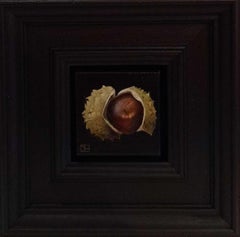
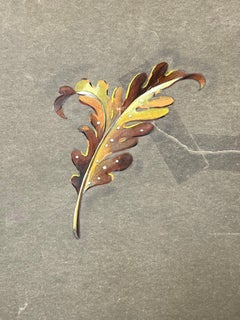
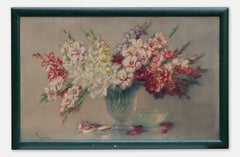
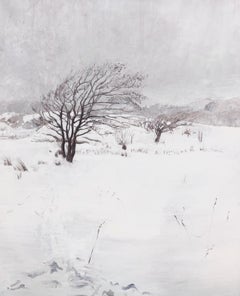
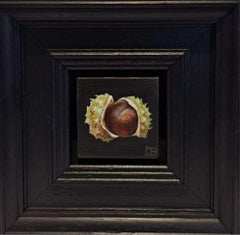
![Dani Humberstone - Pocket Brown Acorn [2023], Baroque Still Life Painting, Small art, Fruit Pocket Brown Acorn [2023], Baroque Still Life Painting, Small art, Fruit](https://a.1stdibscdn.com/dani-humberstone-paintings-pocket-brown-acorn-2023-baroque-still-life-painting-small-art-fruit-for-sale/a_6323/a_137084821704208750421/1_master.jpg?width=240)